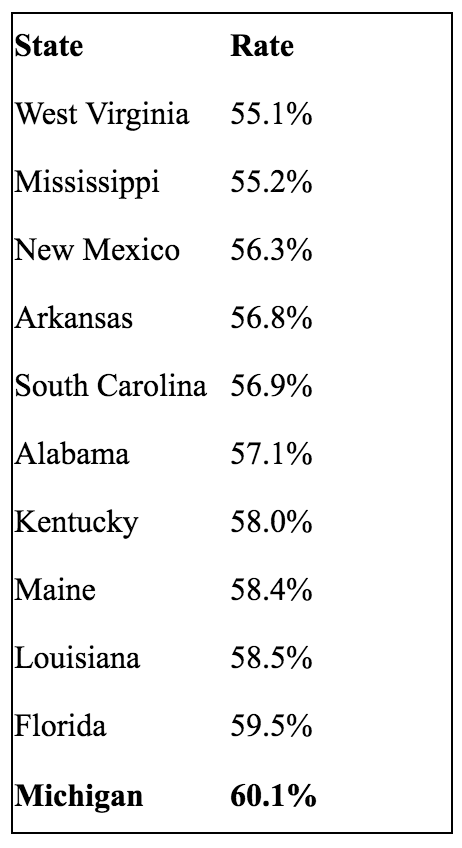By JACK TIMOTHY HARRISON
Capital News Service
LANSING — Michigan’s labor force participation rate is the 11th lowest in the nation, and business leaders are exploring ways to increase employment opportunities.
Having a capable workforce and increasing labor force participation are priorities for the Small Business Association of Michigan, or SBAM, said Brian Calley, its president and chief executive officer.
The rate is the percentage of the population that is working or actively looking for a job. Michigan’s labor force participation rate is 60.1%, below the national average of 62.3%.
Washington, D.C., has the highest rate while West Virginia is at the bottom, according to the Bureau of Labor Statistics.
“We are just over a 60% labor force participation rate, and it’s going to be really hard for us to grow in the future with the size of the labor force that we have today,” Calley said.
To address the problem, Calley said SBAM advocates more employment opportunities for those with disabilities and better access to child care.
He said adequate affordable housing is also part of the solution in areas where the government is incentivizing new businesses.
An example is the General Motors plant being built in Delta Township, he said.
Economics professor Luis de Araujo of Michigan State University closely monitors the labor force participation rate.
Although the pandemic decreased the rates nationwide, Araujo said there are structural reasons that explain Michigan’s lower rate, including a gap between employers’ needs and workers’ skills.
“If this gap is large, workers find it hard to get a job and may drop out of the labor force if the search for a job takes too long and is quite frustrating,” Araujo said.
Other business organizations are also addressing the issue, including the Michigan Chamber of Commerce.
Wendy Block, its senior vice president of business advocacy and membership, said the organization has “been looking and working with others in the business community at some of those key barriers to employability.” That requires looking “through a lot of different lenses.”
The pandemic was a major factor that hurt labor force participation because many people became detached from the workforce, Block said.
For others, it can be difficult to enter the workforce because of other costs, including child care.
Block said the chamber supports efforts such as the Tri-Share program, where the employee, employer and state all split a third of the cost of child care.
“That has been very successful because it allows employers to put some skin in the game, alongside their individual employee, and for the state to have some data to see whether this moves the mark,” Block said.
Workforce training is important to prepare prospective employees and to ready existing workers for future jobs, according to Block.
She cited the Michigan Reconnect Program that provides free in-district community college courses to those 25 or older seeking an associate degree, and the state-funded Going Pro Talent Fund that provides employers with grants to train current employees and attract new ones.
Block said those initiatives have successfully matched companies with prospective workers with the necessary skills.
Calley said the Reconnect Program is more beneficial for smaller businesses because it’s intended for individuals, rather than for a cohort, which is primarily for larger businesses.
He said SBAM worked with the Chamber of Commerce and other organizations to establish the program.
“When that legislation was being crafted, we were right there as part of that process, so I think Reconnect is a good example of the sort of innovation that puts workforce development programs more in reach of a small business,” he said.
As the new Democratic Legislature considers policies that could change the state’s economic environment, Block said the majority’s policy agenda created a “mixed bag of issues for the business community.”
For example, the chamber and SBAM both oppose repealing Michigan’s right-to-work law, which labor unions strongly criticize.
However, Block said the chamber supports other legislative actions, such as expansion of the Earned Income Tax Credit beyond 6%, to help retain workers. The credit helps lower-income working families.

Federal Reserve Bank of St. Louis
The states with the lowest labor participation rate, including Michigan in 11th place.